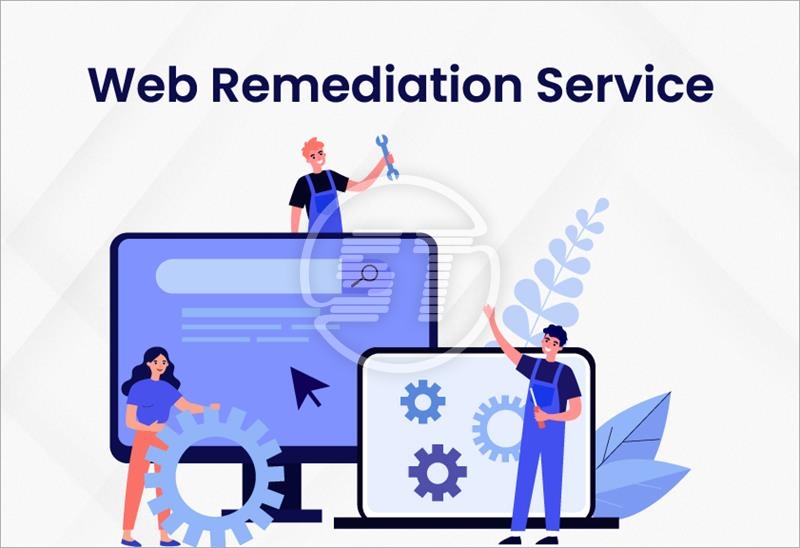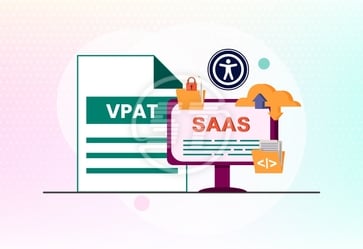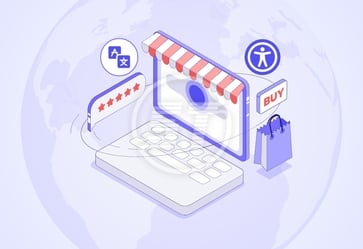E-commerce advancements have transformed the way we shop, with convenience being the primary driver of its popularity. Yet, many e-commerce websites still overlook accessibility. According to research conducted by Baymard, “94% of the largest eCommerce websites are not accessibility compliant.”
Shopping is an activity that everyone engages in, and as digital dynamics evolve, e-commerce brand owners must stay updated not just with their product categories but also with the law.
An e-commerce website or application should be open to everyone, especially for those who may face challenges accessing it. But even today, many e-commerce brands struggle to make their shopping carts, checkout processes, and payment systems truly accessible.
The stakes are higher than ever. Legal pressures, from ADA compliance requirements in the United States and the EAA about to take effect in Europe, are mounting on every e-commerce business. Businesses can no longer afford to treat accessibility as an afterthought.
In this blog, I’ll give some actionable tips on optimizing your shopping cart, streamlining the checkout process, and payment gateways. This way, you’ll be able to create an accessible design offering better experiences to everyone, increasing conversions, and customer satisfaction.
Why Does E-Commerce Accessibility Matter
The very era of e-commerce accessibility is geared towards ensuring the usability of shopping platforms for people with disabilities. Countless lawsuits are filed every year against companies whose digital content is not accessible, making it even more critical to implement these restrictions. Such lawsuits will drain the corporate pocket and damage the brand’s reputation. It’s a legal and ethical responsibility you can’t ignore in this day and age.
Beyond legal requirements, making your website accessibility compliant can assist your business in performing better across multiple metrics, which are as follows:
- Expanded market reach: Almost 16% of the world’s population has some disability. Making your e-commerce website accessible allows you access to a market that represents over $13 trillion in annual disposable income.
- Improved SEO performance: Complying with the accessibility standards aligns your website with SEO best practices. This results in a better ranking of your website and webpages.
- Enhanced user experience: An accessible e-commerce website improves user experience as it offers clear navigation, proper labeling, and intuitive design, benefiting all users.
- Reduces costs: Companies keeping accessibility in view from the initial development stages cost significantly less than retrofitting.
Imagine a scenario wherein a customer using a screen reader can’t navigate through the cart, or a user with motor disabilities can’t complete the checkout process; in such a situation, you didn’t just lose a sale but a potential customer for life.
How to Optimize Shopping Carts
One of the most essential features for an e-commerce website is a shopping cart. Use a shopping cart to remind shoppers of what they want from the store. But, for a person with a disability, it can be a challenge because there are way too many controls on the cart, and if those controls are not marked properly, it can become confusing and frustrating.
You can address the challenges by implementing the following tips:
Labelled buttons and form input fields
Shopping carts are web-developed forms consisting of data tables. To make the carts equally accessible, especially to people with disabilities, give descriptive labels to all the data fields, including dropdown menus, checkboxes, and radio buttons. Labeled text must be crisp and should clearly explain the action.
Easy product modification
Most of the time, users change their decision at the last minute and make modifications to their selected products. Abled users would encounter no issue in modifying their products. But it can be an annoying experience for users with vision or cognitive disabilities. If the option is not usable or located properly. To address this issue, keep your cart design simple and intuitive so that such users don’t need to click through several elements.
Accessible feedback
In addition to feedback, error messages must be provided in a clear and accessible manner. For users with visual and hearing disabilities, add different cues like color changes, icons, or audio descriptions.
Messages like “Product Added,” “Product Removed,” etc., must be provided as feedback to users utilizing screen readers. So that they can navigate the shopping cart effectively.
Now, we’ll move on to checkout pages and their optimization.
Optimizing Checkout Pages for Universal Access
After the shopping cart, the checkout process represents the final hurdle between browsing and purchasing; making it accessible is crucial for improving conversion rates and customer experience.
Here’s how you optimize them.
Form field excellence:
Every form field in your checkout process should have clear, descriptive labels that remain visible even when the field is focused. Placeholder text isn’t sufficient; it disappears when users start typing and isn’t reliably announced by screen readers.
The required fields must be marked both visually and programmatically. Using asterisks alone isn’t enough; the required status needs to be communicated to assistive technologies through proper HTML attributes or ARIA labels.
Error prevention and correction
Implement real-time validation that helps users correct mistakes as they occur, rather than waiting until form submission to highlight problems. When errors do occur, provide clear, specific instructions for corrections. Error messages should be programmatically associated with their corresponding fields and announced by screen readers immediately when they appear.
Supporting assistive technologies
Effective ARIA implementation is crucial for complex checkout interfaces. Use ARIA landmarks to help users navigate sections like “Billing Information,” “Shipping Details,” and “Payment Method.”
Live regions should announce important updates like shipping cost calculations and promo code applications without disrupting the user’s current focus.
For multi-step checkout processes, implement clear headings and section breaks that create a logical document structure. Users should be able to navigate between sections using heading navigation in their screen readers.
Making Payment Gateways Accessible
Payment processing involves third-party integration. Due to this integration, accessibility barriers may occur that are beyond your control. Here are the strategies to ensure payment gateway accessibility.
Opt for an accessible payment gateway
The payment gateway you choose should be keyboard accessible, compatible with common screen readers, and provide support for other assistive technologies. It should also have a clean and simple user interface with straightforward instructions. These elements enhance usability for all users, not just those with disabilities.
Mobile device compatibility
A majority of customers prefer to shop on their smartphones, and studies suggest that 61% of users are unlikely to return to an inaccessible website. Want to avoid losing conversions? Make sure that the payment gateway you are choosing is compatible with your mobile devices.
Alternative payment methods
Today, offering just one payment option isn’t a viable option. Some users may find certain payment interfaces more accessible than others. Digital wallets like Apple Pay or Google Pay often provide a streamlined, accessible experience.
Making these suggested changes will make your website compliant with accessibility standards and allow you to improve the user experience.
Testing Strategies
Many common accessibility mistakes can be identified with automated testing tools. Tools such as Axe-Core, WAVE, and Lighthouse accessibility audits may detect missing alt text, color contrast issues, or inappropriate heading structure.
On the other hand, manual testing is also required. Use just a computer keyboard to go through the entire checkout process. Utilize screen readers such as NVDA or JAWS to know what your content sounds like to the blind.
Finally, one of the most important things is to involve disabled people in testing. People with disabilities are the only ones who can provide real-life experience that no automatic tool or able-bodied tester can reproduce. Accessibility is not an achievement that can be done once. Continue testing for accessibility in the development process to prevent some problems in production.
Finally, regular auditing by the professionals in accessibility will focus on what could be and ensure the accessibility of the e-commerce site to adjust to the technologies and developments made.
The Path Forward
Designing accessible e-commerce experiences takes more than the development team’s commitment. Product managers are also responsible for prioritizing accessibility features. Designers should keep all users’ diversity in mind from the start. Moreover, the quality assurance teams should include assessment and testing for accessibility. Accessibility pays off more than mere compliance. Typically, making an e-commerce website more accessible results in cleaner code, improved performance, and a better user experience for all users.
Clear labeling helps all users understand your interface better. Logical navigation benefits both screen reader users and customers browsing on mobile devices in bright sunlight. For businesses serious about inclusive design, partnering with accessibility web development experts can accelerate progress and ensure comprehensive implementation.
For businesses serious about inclusive design, partnering with accessibility web development experts can accelerate progress and ensure comprehensive implementation. Our professional audit and remediation services identify issues and offer a systematic roadmap towards complete accessibility.
Wrapping Up
You need to make significant improvements to your website to ensure that it’s accessible to everyone. Legal accessibility standards are getting more stringent; following these accessibility guidelines, businesses can benefit exponentially. It seems that accessibility has become a necessity.
Make sure that you refine the entire user journey, like
- product search,
- shopping cart functionality, and
- checkout completion.
These are high-impact areas in a buyer’s journey; amending your website’s accessibility structure has a positive effect on your conversion rate and customer satisfaction.
For specific guidance on platform implementations, explore resources on making your Shopify store ADA and WCAG compliant or learn how ADA-compliant e-commerce stores enhance user experience and conversions.
Are you looking to future-proof your e-commerce business by making it compliant with global accessibility laws?
Skynet Technologies offers advanced, comprehensive solutions. Our All in One Accessibility widget is designed to make your website compliant with accessibility standards, boost conversion rates, and reduce the risk of legal repercussions.
Moreover, Skynet Technologies offers comprehensive premium add-on services like
- Website accessibility audit for identifying accessibility issues and their effective resolution.
- Generating a VPAT report & ACR (Accessibility Conformance Report) to avoid legal repercussions.
- ADA web accessibility remediation for better market penetration, gaining a competitive edge, better user experience, and usability, etc.
For more competitive services and better compliance with accessibility laws like ADA, EAA/EN 301 549, WCAG, and many more.
Contact us today or email us at hello@skynettechnologies.com with your requirements.


